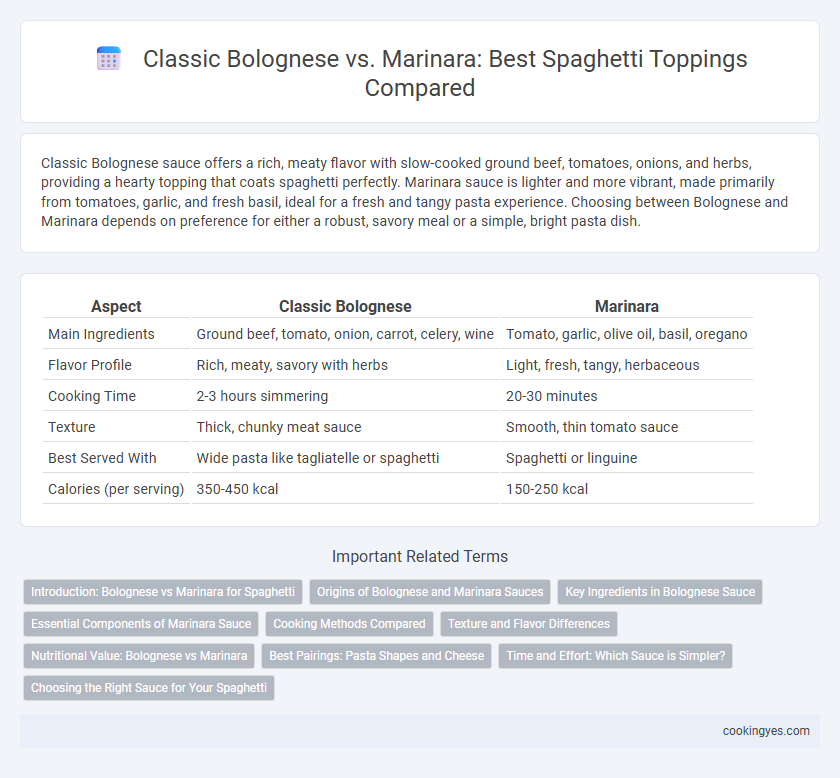Classic Bolognese sauce offers a rich, meaty flavor with slow-cooked ground beef, tomatoes, onions, and herbs, providing a hearty topping that coats spaghetti perfectly. Marinara sauce is lighter and more vibrant, made primarily from tomatoes, garlic, and fresh basil, ideal for a fresh and tangy pasta experience. Choosing between Bolognese and Marinara depends on preference for either a robust, savory meal or a simple, bright pasta dish.
Table of Comparison
| Aspect | Classic Bolognese | Marinara |
|---|---|---|
| Main Ingredients | Ground beef, tomato, onion, carrot, celery, wine | Tomato, garlic, olive oil, basil, oregano |
| Flavor Profile | Rich, meaty, savory with herbs | Light, fresh, tangy, herbaceous |
| Cooking Time | 2-3 hours simmering | 20-30 minutes |
| Texture | Thick, chunky meat sauce | Smooth, thin tomato sauce |
| Best Served With | Wide pasta like tagliatelle or spaghetti | Spaghetti or linguine |
| Calories (per serving) | 350-450 kcal | 150-250 kcal |
Introduction: Bolognese vs Marinara for Spaghetti
Classic Bolognese sauce features a rich, slow-cooked blend of ground beef, tomatoes, onions, and aromatic herbs, delivering a hearty and savory topping for spaghetti. Marinara sauce is a lighter, tomato-based sauce with garlic, basil, and olive oil, offering a fresh and vibrant flavor profile. Choosing between Bolognese and Marinara depends on whether you prefer a dense, meaty sauce or a simple, tangy tomato topping for your spaghetti.
Origins of Bolognese and Marinara Sauces
Bolognese sauce, originating from Bologna, Italy, is a rich meat-based sauce made with ground beef, pork, vegetables, and tomato, simmered slowly to develop deep flavors. Marinara sauce, rooted in Naples, Italy, is a simple, vibrant tomato-based sauce flavored with garlic, onions, and herbs without any meat. The distinct origins of these sauces reflect regional differences in Italian cuisine, with Bolognese embodying northern Italy's hearty traditions and Marinara showcasing the southern emphasis on fresh, light ingredients.
Key Ingredients in Bolognese Sauce
Classic Bolognese sauce features key ingredients such as ground beef, pancetta, onions, carrots, celery, garlic, tomatoes, red wine, and a splash of milk or cream to create a rich, hearty texture. The slow-cooked mixture develops deep umami flavors, making it distinctively more robust than the simpler tomato-based Marinara sauce, which primarily includes tomatoes, garlic, olive oil, and basil. These key components give Bolognese its signature savory depth, perfect for pairing with spaghetti.
Essential Components of Marinara Sauce
Marinara sauce, a staple for spaghetti, is characterized by its essential components: ripe tomatoes, garlic, olive oil, and fresh herbs such as basil and oregano. Unlike Classic Bolognese, which emphasizes a rich, slow-cooked meat base, marinara offers a lighter, vibrant flavor profile ideal for quick preparation. The simplicity and freshness of marinara sauce highlight the natural sweetness of tomatoes, making it a versatile topping for various pasta dishes.
Cooking Methods Compared
Classic Bolognese sauce involves slow-simmering ground meat, tomatoes, and aromatic vegetables for several hours to develop deep, rich flavors, while Marinara sauce is a quicker preparation made by sauteing garlic and onions before simmering fresh tomatoes and herbs for about 20-30 minutes. Bolognese requires a longer cooking time and more ingredients, resulting in a thicker, hearty sauce with a complex taste. Marinara is lighter, fresher, and ideal for quick meals, emphasizing the bright acidity of ripe tomatoes.
Texture and Flavor Differences
Classic Bolognese sauce features a rich, meaty texture with slow-cooked ground beef, pork, and a creamy mix of tomatoes, wine, and milk, offering a savory, umami-packed flavor. Marinara sauce contrasts with a light, smooth texture made from fresh tomatoes, garlic, and herbs, delivering a bright, tangy, and slightly sweet taste. The hearty, thick consistency of Bolognese pairs well with wide pasta like tagliatelle, while the thinner, vibrant marinara complements long, thin spaghetti strands.
Nutritional Value: Bolognese vs Marinara
Classic Bolognese sauce offers a higher protein content due to its ground beef base, while marinara sauce is lower in calories and fat because it consists mainly of tomatoes and herbs. Bolognese provides essential nutrients such as iron and vitamin B12, contrasting with marinara's richness in antioxidants and vitamin C. Choosing between the two depends on dietary goals, with Bolognese favoring protein intake and marinara supporting heart-healthy, low-calorie diets.
Best Pairings: Pasta Shapes and Cheese
Classic Bolognese pairs best with wide pasta shapes like tagliatelle or pappardelle, as their flat surfaces hold the rich, meaty sauce effectively, complemented by Parmesan or Pecorino Romano cheese for added depth. Marinara sauce suits thinner, more delicate pasta such as spaghetti or linguine, allowing its bright tomato and herb flavors to shine, enhanced by fresh mozzarella or grated Parmesan for a creamy texture. Choosing the right cheese and pasta shape amplifies the unique characteristics of each traditional sauce.
Time and Effort: Which Sauce is Simpler?
Classic Bolognese requires several hours of slow simmering to develop its rich, meaty flavors, demanding more time and culinary effort. Marinara sauce, made primarily from fresh tomatoes, garlic, and herbs, can be prepared in under 30 minutes, making it a quicker and simpler option. For those seeking efficiency, marinara offers a fresh, flavorful topping with minimal preparation compared to the labor-intensive Bolognese.
Choosing the Right Sauce for Your Spaghetti
Classic Bolognese sauce, rich with ground beef, tomatoes, and aromatic vegetables, provides a hearty and savory topping that perfectly complements thick spaghetti strands. Marinara sauce, made from pureed tomatoes, garlic, and herbs, offers a lighter, tangier option that enhances the pasta's texture without overwhelming it. Selecting between Bolognese and Marinara depends on whether you prefer a robust, meaty flavor or a fresh, vibrant tomato taste for your spaghetti.
Classic Bolognese vs Marinara for spaghetti topping Infographic

 cookingyes.com
cookingyes.com